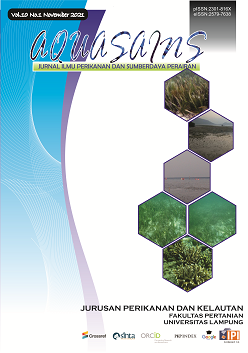Habitat and Distribution of Desmopuntius gemellus (Kottelat, 1998) at Palm Oil Plantation Canal Near Pidada River, Tulang Bawang, Lampung
DOI:
https://doi.org/10.23960/aqs.v10i1.p973-978 Abstract View: 499
Abstract View: 499
Abstract
Desmopuntius gemellus is a native species of peat swamp waters in Southeast Asia. This fish is economically important value for the local community, for example as consumption fish and as bait to catch carnivorous fish. Until now there has been no management effort to protect the sustainability of the fish. Ecobiology studies are needed as initial information in managing this fish. Samples were collected from primary and secondary canal stations at the palm oil plantation in Penawartama District, Tulang Bawang Regency during October 2019 to January 2020. A total of 1,088 fish samples were collected by using lift net, with the most distribution in the secondary canal. Main component analysis shows that secondary canal stations are more characterized by temperature parameters. And the primary canal is characterized by depth, brightness, current, and dissolved oxygen.Downloads
References
Kottelat, M. 1996. The identity of Puntius eugrammus and diagnoses of two new spesies of striped barbs (Teleostei : Cyprinidae) from Southeast Asia. The Raffles Bulletin of Zoology 44 (1) : 301-316.
Kottelat, M., 2013. The fishes of the inland waters of southeast Asia: a catalogueq and core bibiography of the fishes known to occur in freshwaters, mangroves and estuaries. The Raffles Bulletin of Zoology Supplement 27: 1-663.
Cattel, R.B. 1966. The scree test for the number of factor. Multivariate Behavioral Rese-arch 1:245-276.
Kaiser, H.F. 1960. The application of electronic computers to factor analysis. Educa-tional and Psychological Measurement 20: 141-151.
Prianto, E. 2015. Aspek reproduksi dan dinamika larva ikan sebagai dasar pe-ngelolaan sumberdaya ikan di paparan banjiran Lubuk Lampam Provinsi Suma-tera Selatan. Disertasi. Sekolah Pasca-sarjana, Institut Pertanian Bogor. 92 hal.
Rachman, T. 2015. Prediksi distribusi dan kelimpahan dari persediaan ikan yang ditentukan berdasarkan kondisi ling-kungan. Makalah Oseanografi Perika-nan. Program Studi Oseanografi, Fakul-tas Teknologi dan Ilmu Kebumian, Insti-tut Teknologi Bandung. 18 hal.
Rizal, D.A. 2009. Studi biologi reproduksi ikan senggiringan (Puntius johorensis) di da-erah aliran sungai (DAS) Musi, Sumatra Selatan. Skripsi. Departemen Manajemen Sumberdaya Perairan. Fakultas Perika-nan dan Ilmu Kelautan. Institut Pertanian Bogor. 62 hal.
Downloads
Published
How to Cite
Issue
Section
License
License for Authors
Authors who publish with this journal agree to the following terms:
- Authors retain copyright and grant the journal right of first publication with the work simultaneously licensed under a Creative Commons Attribution License that allows others to share the work with an acknowledgement of the work's authorship and initial publication in this journal.
- Authors are able to enter into separate, additional contractual arrangements for the non-exclusive distribution of the journal's published version of the work (e.g., post it to an institutional repository or publish it in a book), with an acknowledgement of its initial publication in this journal.
- When the article is accepted for publication, its copyright is transferred to Aquasains Journal. The copyright transfer convers the exclusive right to reproduce and distribute the article, including offprint, translation, photographic reproduction, microfilm, electronic material, (offline or online) or any other reproduction of similar nature.
- Authors are permitted and encouraged to post their work online (e.g., in institutional repositories or on their website) prior to and during the submission process, as it can lead to productive exchanges, as well as earlier and greater citation of published work (See The Effect of Open Access).
- The Author warrant that this article is original and that the author has full power to publish. The author sign for and accepts responsibility for releasing this material on behalf os any and all-author. If the article based on or part os student’s thesis, the student needs to sign as his/her agreement that his/her works is going published.
License for Regular Users
Other regular users who want to cite, distribute, remix, tweak, and build upon author’s works, even for commercial purposes, should acknowledge the work’s authorship and initial publication in this journal, licensed under a Creative Commons Attribution License.
This license lets others distribute, remix, tweak, and build upon your work, even commercially, as long as they credit you for the original creation.
This work is licensed under a Creative Commons Attribution 4.0 International License.Copyright Transfer Statement can be downloaded here


.png)









